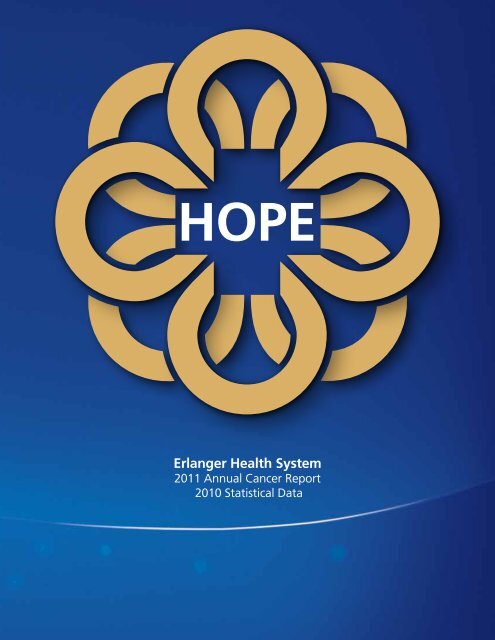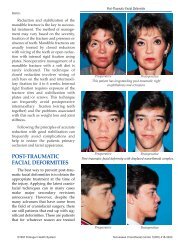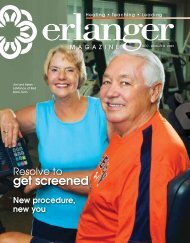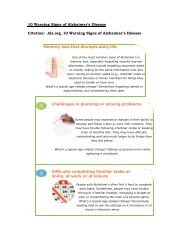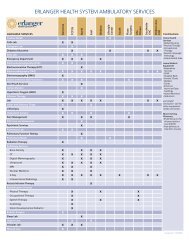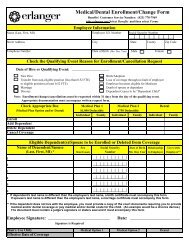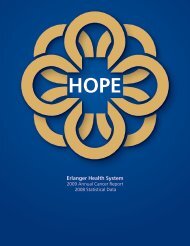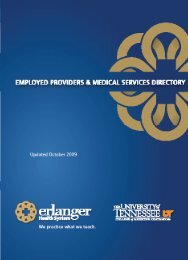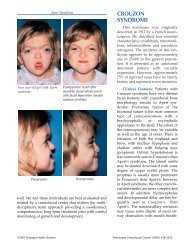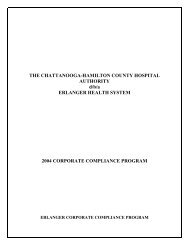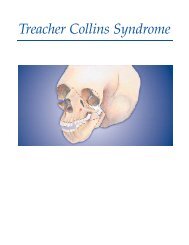2011 Cancer Committee Members - Erlanger Health System
2011 Cancer Committee Members - Erlanger Health System
2011 Cancer Committee Members - Erlanger Health System
Create successful ePaper yourself
Turn your PDF publications into a flip-book with our unique Google optimized e-Paper software.
<strong>Erlanger</strong> <strong>Health</strong> <strong>System</strong><br />
<strong>2011</strong> Annual <strong>Cancer</strong> Report<br />
2010 Statistical Data
Table of Contents<br />
1<br />
Table of Contents<br />
Adult Oncology 2<br />
Pediatric Oncology 3<br />
<strong>2011</strong> <strong>Cancer</strong> Activities 4<br />
<strong>2011</strong> <strong>Cancer</strong> <strong>Committee</strong> <strong>Members</strong> 5–6<br />
<strong>2011</strong> <strong>Cancer</strong> <strong>Committee</strong> Report/Goals 7<br />
<strong>2011</strong> Participating <strong>Cancer</strong> Program 8–9<br />
Physicians & Specialty Services<br />
<strong>2011</strong> <strong>Cancer</strong> Conference Report 10<br />
<strong>2011</strong> <strong>Cancer</strong> Services & Support 11–13<br />
<strong>2011</strong> <strong>Cancer</strong> Registry Report 14<br />
2010 <strong>Cancer</strong> Site Distribution List 15<br />
2010 Geographic Distribution 16<br />
2010 <strong>Cancer</strong> Incidence 17<br />
2010 Treatment Combinations 18<br />
Female/Male Comparison of Selected 19<br />
<strong>Cancer</strong> Sites<br />
2010 Distribution by AJCC Stage 20<br />
& Collaborative Stage<br />
Ten-Year Comparison of Major Site 21<br />
Groupings at <strong>Erlanger</strong><br />
Prostate <strong>Cancer</strong> & Prostate <strong>Cancer</strong> Studies 22-24<br />
Uterine Corpus 25<br />
On behalf of the <strong>Cancer</strong> Program at<br />
the <strong>Erlanger</strong> <strong>Health</strong> <strong>System</strong>, the <strong>Cancer</strong><br />
<strong>Committee</strong> is pleased to present the<br />
<strong>2011</strong> Annual Report.<br />
The <strong>Erlanger</strong> <strong>Health</strong> <strong>System</strong> is accredited<br />
by the American College of<br />
Surgeons’ Commission on <strong>Cancer</strong> as a<br />
Teaching Hospital <strong>Cancer</strong> Program.<br />
This accreditation—and the required<br />
standards we follow—demonstrate<br />
our commitment to provide our cancer<br />
patients and their families with the<br />
best cancer care and support possible.<br />
Our <strong>Health</strong>care Mission:<br />
To deliver excellence in medical care<br />
to improve the health status of our<br />
region, while providing vital services to<br />
those in need, and training to health<br />
professionals through affiliation with<br />
academic partners.
Adult Oncology<br />
The <strong>Erlanger</strong> <strong>Health</strong> <strong>System</strong> has been accredited by<br />
the American College of Surgeons’ (ACoS) Commission<br />
on <strong>Cancer</strong> (CoC) as a Teaching Hospital<br />
<strong>Cancer</strong> Program since 1981. This accreditation is<br />
granted only to facilities that voluntarily commit to<br />
provide the best in cancer diagnosis and treatment,<br />
and comply with the established CoC standards.<br />
Each cancer program must undergo a rigorous evaluation<br />
and review of its performance and compliance<br />
with the CoC standards. To maintain accreditation,<br />
facilities with accredited cancer programs<br />
must undergo an on-site review every 3 years.<br />
The Accreditations Program is concerned with prevention,<br />
early diagnosis, pretreatment evaluation,<br />
staging, optimal treatment and rehabilitation, surveillance<br />
for recurrent disease, support services, and<br />
end-of-life care.<br />
Obtaining care from a CoC-accredited cancer<br />
program ensures that one will receive the<br />
following:<br />
Quality care close to home<br />
Comprehensive care offering a range of state-ofthe-art<br />
services and equipment<br />
A multi-disciplinary, team approach to coordinate<br />
the best cancer treatment options available,<br />
utilizing national treatment guidelines —National<br />
Comprehensive <strong>Cancer</strong> Network (NCCN)<br />
Access to cancer related information, education<br />
and support<br />
A cancer registry that collects data on cancer type,<br />
stage, treatment results and offers lifelong patient<br />
follow up<br />
Ongoing monitoring and improvement of care<br />
Information about clinical trials and new<br />
treatment options<br />
Five key elements to the success of a<br />
Commission on <strong>Cancer</strong> accredited cancer<br />
program:<br />
The clinical services provide state-of-the-art<br />
pretreatment evaluation, staging, treatment, and<br />
clinical follow-up for cancer patients seen at the<br />
facility for primary, secondary, tertiary, or end-oflife<br />
care.<br />
The cancer committee/leadership body leads<br />
the program through setting goals, monitoring<br />
activity, and evaluating patient outcomes and<br />
improving care.<br />
The cancer conferences provide a forum for patient<br />
consultation and contribute to physician education.<br />
The quality improvement program is the<br />
mechanism for evaluating and improving<br />
patient outcomes.<br />
The cancer registry and database is the basis for<br />
monitoring the quality of care.<br />
Recognizing that cancer is a complex group of<br />
diseases, the CoC’s cancer program standards promote<br />
pre-treatment consultation among surgeons,<br />
medical and radiation oncologists, diagnostic radiologists,<br />
pathologists, and other cancer specialties.<br />
This multi-disciplinary cooperation results in improved<br />
patient care.<br />
2<br />
Adult Oncology
3<br />
Pediatric Oncology<br />
Pediatric Oncology<br />
The Center for Childhood and Blood Disorders<br />
at Children’s Hospital at <strong>Erlanger</strong> is an accredited<br />
full member of the Children’s Oncology Group<br />
(COG), a cancer cooperative group that develops<br />
and coordinates cancer clinical research trials<br />
conducted at 238 member institutions. These<br />
institutions include cancer centers from all major<br />
universities and teaching hospitals throughout the<br />
United States, Australia, Canada and Europe. The<br />
trials at each institution are centrally monitored,<br />
and the study results are published in peer reviewed<br />
scientific journals.<br />
Dedicated physicians and nurses treat all children<br />
and adolescent patients in our region and then report<br />
their results to an operations center. This data<br />
is reviewed and shared with all the medical experts<br />
in the network.<br />
At the COG cancer centers, patients with the same<br />
cancer diagnosis are treated exactly the same by following<br />
detailed guidelines called protocols. By comparing<br />
all the results, the COG answers important<br />
medical and scientific questions faster than researchers<br />
working alone. Children treated at these centers<br />
have better outcomes and better survival rates.<br />
Children’s Hospital at <strong>Erlanger</strong> is the region’s<br />
only Comprehensive Childhood <strong>Cancer</strong> and<br />
Blood Disorder Center and serves patients from<br />
Tennessee, Alabama, Georgia and North Carolina.<br />
Over ninety-five percent of the children diagnosed<br />
with cancer in our region receive their treatment at<br />
Children’s Hospital at <strong>Erlanger</strong>, and there are 40-50<br />
new cases of childhood cancer diagnosed annually.<br />
Most children treated for cancer participate in<br />
research studies locally.<br />
Multi-disciplinary care is available with skilled Pediatric-focused<br />
services in: cardiology, endocrinology,<br />
gastroenterology, genetics, infectious diseases, neurology,<br />
radiation therapy, surgery, and the Intensive<br />
Care Unit.<br />
The following cancers are treated at<br />
Children’s Hospital at <strong>Erlanger</strong>:<br />
Acute Lymphoblastic Leukemia<br />
Acute Myelogenous Leukemia<br />
Brain Tumors<br />
Ewing Sarcoma<br />
Germ Cell Tumors<br />
Hepatoblastoma<br />
Hodgkin’s Lymphoma<br />
Langerhans Cell Histiocytosis<br />
Neuroblastoma<br />
Non-Hodgkin’s Lymphoma<br />
Osteosarcoma<br />
Retinoblastoma<br />
Rhabdomyosarcoma<br />
Wilm’s Tumor<br />
Other services include:<br />
<strong>Cancer</strong> Survivorship Program<br />
Child Life Services<br />
Kids <strong>Cancer</strong> Camps<br />
Websites & Books
<strong>2011</strong> <strong>Cancer</strong> Activities<br />
<strong>Erlanger</strong>’s history of treating cancer dates back to 1923. As the diagnosis and treatment of cancer has<br />
evolved, so has the facility. Today with its state-of-the-art treatment methods for children and adults, partnership<br />
with UT College of Medicine Chattanooga, and outstanding medical staff, the <strong>Erlanger</strong> <strong>Cancer</strong> Center<br />
is recognized among the most advanced in the field.<br />
This annual report provides an overview of the <strong>2011</strong> cancer program activities and 2010 statistical data for<br />
the <strong>Erlanger</strong> <strong>Health</strong> <strong>System</strong>.<br />
In <strong>2011</strong>, the <strong>Cancer</strong> <strong>Committee</strong> provided guidance in a number of cancer-related activities including:<br />
Continued American <strong>Cancer</strong> Society collaborations:<br />
Man to Man (Prostate Support Group)<br />
Look Good, Feel Better<br />
Road to Recovery<br />
Official Sponsor of Birthdays and Direct Patient Referrals for <strong>Cancer</strong> Information<br />
Continued physician education through cancer conferences<br />
Expansion of clinical trials and studies (adult and pediatric)<br />
Expansion of services in the Radiation Oncology Department<br />
Expansion of community education/outreach programs:<br />
Breast <strong>Health</strong> Outreach Program grant<br />
New Kids Count programs<br />
New Kids Count Grief Style program<br />
<strong>Health</strong> Fairs<br />
Implemented <strong>Cancer</strong> Resource and Survivorship Center<br />
Improvements of data collection and input in the <strong>Cancer</strong> Registry<br />
Provision of data for special research studies<br />
Participation in community outreach events including:<br />
Principal Sponsor of the Annual Prostate Walk<br />
Sponsor for the Susan G. Komen Race for the Cure<br />
Participation in the ACS 24-hour Relay for Life<br />
4<br />
<strong>2011</strong> <strong>Cancer</strong> Activities<br />
John McCravey, M.D.<br />
<strong>Cancer</strong> <strong>Committee</strong><br />
Chairman<br />
The <strong>Cancer</strong> <strong>Committee</strong> coordinates and facilitates the programs and services offered<br />
by the cancer program. It develops and evaluates annual clinical, programmatic,<br />
quality improvement and community outreach goals; promotes a coordinated and<br />
multi-disciplinary approach to patient management; ensures that educational cancer<br />
conferences cover all the major cancer sites and related issues; promotes clinical<br />
research; supervises the cancer registry and ensures accurate and timely abstracting<br />
and follow-up reporting; and develops community education and outreach programs.
<strong>2011</strong> <strong>Cancer</strong> <strong>Committee</strong> <strong>Members</strong><br />
Physician <strong>Members</strong><br />
John McCravey, M.D.<br />
Medical Oncology<br />
* <strong>Cancer</strong> <strong>Committee</strong> Chairman<br />
Manoo Bhakta, M.D.<br />
Pediatric Medical Oncology<br />
Rhett Blake, M.D.<br />
Interventional Pain Management<br />
Larry Schlabach, M.D.<br />
Medical Oncology<br />
Amar Singh, M.D.<br />
Chief Surgeon/Urologic Oncology<br />
*<strong>Cancer</strong> Liaison Physician<br />
Alvaro Valle, M.D.<br />
Surgical Oncology<br />
Don Chamberlain, M.D.<br />
Gynecologic Oncology<br />
5<br />
<strong>Committee</strong> <strong>Members</strong><br />
Jeffrey Gefter, M.D.<br />
Radiation Oncology, Section Chief<br />
Richard Hessler, M.D.<br />
Chief of Pathology<br />
*Quality of Registry Data Coordinator<br />
Peter Hunt, M.D.<br />
ENT Oncology<br />
Kent Hutson, M.D.<br />
Chief of Radiology<br />
Frank Kimsey, M.D.<br />
Radiation Oncology<br />
*<strong>Cancer</strong> Conference Coordinator<br />
Frank Knight, M.D.<br />
Section Chief Mammography/Radiology<br />
Philip Rayers, M.D.<br />
Hospitalist
<strong>2011</strong> <strong>Cancer</strong> <strong>Committee</strong> <strong>Members</strong><br />
Non-Physician <strong>Members</strong><br />
Geri Abbott, LCSW<br />
Case Management<br />
Dennis Buckelew, D.Ph.<br />
Oncology Pharmacy<br />
Elizabeth Carroll<br />
Oncology Service Line Liaison<br />
Eugenia Clement, RD, LDN<br />
Oncology Dietitian<br />
LaChanda Davis<br />
<strong>Health</strong> Initiative Rep w/ACS<br />
Mary Goodner, RN, BSN<br />
Oncology Research Coordinator<br />
Olen Grubbs<br />
Pastoral Care & Education Director<br />
Sam Harris, M.Div.<br />
Oncology Patient Care Advocate<br />
Gigi Johnson, RN, MSHA, OCN<br />
Oncology Service Line Administrator<br />
Jan Keys, RN, MSN<br />
Associate Administrator of Operations<br />
Janet Kramer-Mai, RN, OCN<br />
<strong>Cancer</strong> Support Services Manager<br />
Michael Lee, CPA<br />
Sr. Financial Analyst<br />
Pat McDougal, RHIT<br />
<strong>Health</strong> Information<br />
Michele McNabb, RN<br />
Oncology Educator<br />
Claire Overmyer, MA, CCC-SLP<br />
Speech Therapy<br />
Paula Reagan, BSRT(T)<br />
Radiation Therapy<br />
Laura Robinson, RN, BSN, OCN, CRNI<br />
Oncology Nurse Manager, CWW7<br />
Candeis Tinsley, LBSW<br />
Oncology Social Worker<br />
Chris Vaughn<br />
Clinical Director of Marketing<br />
Kim Wicks, CTR, CCSP<br />
Oncology Data Management Coordinator<br />
Kathy Wood, RN<br />
Tumor Clinic Manager<br />
6<br />
<strong>Committee</strong> <strong>Members</strong>
<strong>Committee</strong> Report/Goals<br />
<strong>2011</strong> <strong>Cancer</strong> <strong>Committee</strong> Report<br />
7<br />
<strong>Committee</strong> Report/Goals<br />
The members of the cancer committee meet quarterly each year to ensure that administrative responsibilities<br />
related to the cancer program leadership are carried out. These annual responsibilities include but are not<br />
limited to:<br />
appointment of four program coordinators for: cancer conference, quality of cancer registry data,<br />
quality improvement and community outreach development and evaluation of clinical, community<br />
outreach, programmatic endeavors and quality improvement goals<br />
establishment of cancer conference frequency and format<br />
establishment of the multidisciplinary attendance requirement and attendance rate for cancer<br />
conferences<br />
review of cancer conference activity to ensure compliance with the requirements; promote clinical trials<br />
and research<br />
monitor quality management and improvement through completion of quality management studies that<br />
focus on quality, access to care and outcomes<br />
Supervise the cancer registry and ensure accurate and timely abstracting, staging and follow-up<br />
reporting; and perform quality control of registry data.<br />
<strong>2011</strong> <strong>Cancer</strong> <strong>Committee</strong> Goals<br />
Development of the CWW7 adult oncology inpatient unit counsel<br />
Implementation and development of the Cyberknife nurse coordinator position<br />
Implementation and development of the cancer program financial analyst position<br />
Improvement of Pain Management scores of cancer patients<br />
Implementation and development of the cancer resource and survivorship center
Participating Physicians<br />
<strong>2011</strong> Participating <strong>Cancer</strong> Program Physicians and Specialty Services<br />
Colon & Rectal Surgery<br />
Richard Moore, M.D.<br />
Shauna Lorenzo-Rivero, M.D.<br />
J. Daniel Stanley, M.D.<br />
Gastroenterology<br />
Steven Kessler, M.D.<br />
Specializes in Endoscopic Retrograde<br />
Cholangiopancreatogram (ERCP)<br />
Louis Lambiase, M.D.<br />
Specializes in Endoscopic Ultrasound (EUS) &<br />
Retrograde Cholangiopancreatogram (ERCP)<br />
Hemchand Ramberan, M.D.<br />
Specializes in Endoscopic Retrograde<br />
Cholangiopancreatogram (ERCP)<br />
Genetics<br />
Kristin May, Ph.D., Cytogenetics<br />
Cathy Stevens, M.D., Board Certified<br />
Medical Genetics<br />
Madison Foster, M.S.<br />
Jill Pouncey, M.S., Board Certified Genetics<br />
Counselor<br />
Gynecologic Oncology<br />
Don Chamberlain, M.D.<br />
Stephen DePasquale, M.D.<br />
Medical Oncology<br />
John McCravey, M.D.<br />
Lawrence Nagle, M.D.<br />
Larry Schlabach, M.D.<br />
Neurosurgery<br />
Peter Boehm, M.D.<br />
Michael Gallagher, M.D.<br />
Richard Kern, M.D.<br />
Daniel Kueter, M.D.<br />
Philip Megison, M.D.<br />
Timothy Strait, M.D.<br />
Pathology<br />
Richard Hessler, M.D.,<br />
Chief of Pathology<br />
Anatomic Pathology & Neuropathology<br />
Eric Chand, M.D.<br />
Anatomic & Clinical Pathology<br />
Cytopathology<br />
Anne Herdman, M.D.<br />
Anatomic & Clinical Pathology;<br />
GI/Liver Pathology<br />
Crystal Jenkins, M.D.<br />
Anatomic & Clinical Pathology; GI/Liver<br />
Pathology<br />
Joyce Mills, M.D.<br />
Anatomic & Clinical Pathology<br />
David Spence, M.D.<br />
Anatomic & Clinical Pathology;<br />
Hematopathology & Pediatric Pathology<br />
Pediatric Oncology<br />
Manoo Bhakta, M.D<br />
Eric Gratias, M.D<br />
Jennifer Keates, M.D.<br />
Avery Mixon, M.D.<br />
Pediatric Radiology<br />
Marla Sammer, M.D., Section Chief, Pediatrics<br />
Specializing in Pediatric Radiology<br />
Lynn Carlson, M.D., Pediatric Radiologist<br />
Specializing in Pediatric Radiology<br />
Tatum Johnson, M.D., Pediatric Radiologist<br />
Specializing in Pediatric Radiology<br />
Pediatric Surgery<br />
Michael Carr, M.D.<br />
Pete Kelley, M.D.<br />
Curt Koontz, M.D.<br />
Lisa Smith, M.D.<br />
8<br />
Participating Physicians<br />
Otolaryngology<br />
David Barnes, M.D., ENT Oncology<br />
Mark Bookout, M.D.<br />
Jack Greer, M.D.<br />
Hathaway Harvey, M.D.<br />
Peter Hunt, M.D., ENT Oncology<br />
H. Joseph Lantz, M.D.<br />
Douglas Liening, M.D.<br />
Joseph Motto, M.D.<br />
Chris St. Charles, M.D.
Participating Physicians (continued)<br />
9<br />
Participating Physicians<br />
<strong>2011</strong> Participating <strong>Cancer</strong> Program Physicians and Specialty Services<br />
Pulmonary Diseases<br />
John Boldt, Jr., M.D.<br />
Suresh Enjeti, M.D.<br />
Radiation Oncology<br />
Jeffrey Gefter, M.D. (Adult and Pediatric)<br />
Frank Kimsey, M.D. (Adult)<br />
Radiology<br />
Blaise Baxter, M.D.<br />
Specializing in Interventional Radiology<br />
Kent Hutson, M.D., Chief of Radiology<br />
Specializing in Neuroradiology, MRI & Radiology Informatics<br />
Peter Furicchia, M.D., Section Chief, Ultrasound<br />
Specializing in Body Imaging & Nuclear Medicine<br />
Michael Hertzog, M.D., Section Chief,<br />
Radiography/Fluoroscopy<br />
Specializing in Body Imaging & CT Angiography<br />
Pradeep Jacob, M.D., Section Chief, Nuclear<br />
Medicine<br />
Specializing in Neuroradiology, Nuclear Medicine & MRI<br />
Frank Knight, M.D., Section Chief,<br />
Mammography<br />
Eugene Long, M.D., Diagnostic Radiologist<br />
Specializing in Body Imaging & Mammography<br />
Jacob Noe, M.D., Diagnostic Radiology<br />
Specializing in Neuroradiology<br />
Roxsann Roberts, M.D., Diagnostic Radiologist<br />
Specializing in Neuroradiology, MRI & Mammography<br />
Stephen Sabourin, M.D., Diagnostic Radiology<br />
Specializing in Body & Musculoskeletal Imaging & MRI<br />
Ronald Waters, M.D., Section Chief, Computed<br />
Tomography<br />
Specializing in Body and Musculoskeletal Imaging & MRI<br />
Steven Quarfordt, M.D.<br />
Specializing in Interventional Radiology<br />
General Surgery<br />
Phillip Burns, M.D.<br />
Todd Cockerham, M.D.<br />
Joseph Cofer, M.D.<br />
Benjamin Dart, M.D.<br />
Daniel K. Fisher, M.D.<br />
Michael Greer, M.D.<br />
Robert Maxwell, M.D.<br />
Vicente Mejia, M.D.<br />
Linda Pate, M.D.<br />
Michael Roe, M.D.<br />
Philip Smith, M.D.<br />
Alvaro Valle, M.D., Surgical Oncology<br />
Laura Witherspoon, M.D.<br />
Thoracic Surgery<br />
James Headrick, M.D.<br />
Stephen Martin, M.D.<br />
James Zellner, M.D.<br />
Urology<br />
Amar Singh, M.D., Chief, Minimally<br />
Invasive Surgery, Urologic Oncology<br />
Norman Galen, M.D.<br />
Colin Goudelocke, M.D.<br />
Argil Wheelock, M.D.
<strong>2011</strong> <strong>Cancer</strong> Conference Report<br />
Multi-disciplinary cancer conferences provide an opportunity for allied health professionals and physicians,<br />
from different specialty groups, to come together to discuss the patient’s medical history, physical findings,<br />
pathology and radiology results, tumor staging, clinical management and prognosis. These forums provide<br />
consultative services for patients and education to physicians and support staff.<br />
Representation from Gynecologic, Medical (Adult and Pediatric), Radiation, Surgical (Colorectal/Head<br />
and Neck/General/Pediatric/Neurologic) and Urologic Oncology; Internal Medicine, Pediatric and Surgical<br />
Residents; Pathology, Diagnostic Radiology, Nursing, Nutrition and support staff are active participants<br />
in these conferences. By bringing these individuals together, patients are offered the latest and most optimal<br />
treatment options.<br />
In <strong>2011</strong>, cancer conference physician attendance/representation from the following specialties:<br />
medical oncology, surgery, pathology, radiation oncology, and radiology were 100%.<br />
General conference is held every Friday, Gynecologic-focused conference is held every third Tuesday and<br />
Pediatric-focused conference is held the first Friday of the month as requested. *If there is an emergent adult<br />
case, it may be presented at the Pediatric-focused conference.<br />
During <strong>2011</strong>, there was a total of 59 cancer conferences with 321 cases presented. Ninety-nine percent of<br />
the cases presented were prospective cases. Prospective case presentation addresses patient management<br />
issues and includes AJCC stage (either clinical stage or working stage) and treatment options for each case.<br />
Prospective cases include, but are not limited to: newly diagnosed and treatment not yet initiated; newly diagnosed<br />
and treatment initiated, but discussion of additional treatment is needed; and previously diagnosed<br />
and discussion of supportive or palliative care is needed.<br />
<strong>2011</strong> Top <strong>Cancer</strong> Sites/Cases Reviewed<br />
General Conference: Breast, Bladder, Prostate, Kidney, Lymphoma, Sarcoma, Lung, Melanoma, Brain<br />
and Stomach<br />
GYN Conference: Endometrium, Ovary, Cervix, Vulva and Other<br />
10<br />
<strong>Cancer</strong> Conference Report<br />
Pediatric-Focused Conference: Leukemia, Lymphoma, Brain and Kidney
The latest treatment options for children and adults<br />
The Chattanooga Tumor Clinic is a privately funded independent charity clinic located at <strong>Erlanger</strong><br />
Hospital. The clinic was established in 1936 as a non-profit organization to provide services to the underserved<br />
cancer patients in the community. The clinic is staffed by oncology trained nurses and a multi-disciplinary<br />
team of volunteer physicians.<br />
Clinical Research means <strong>Erlanger</strong> and the Children’s Hospital cancer patients have access to the largest<br />
variety and most advanced treatment options in the region – all monitored and approved by the UT College<br />
of Medicine Chattanooga Institutional Review Board. Affiliations include Vanderbilt-Ingram <strong>Cancer</strong> Center<br />
Affiliate Network (VICCAN), Eastern Cooperative Oncology Group (ECOG), and the Clinical Trials<br />
Support Unit (CTSU) and Children’s Oncology Group (COG).<br />
11<br />
<strong>Cancer</strong> Services & Support<br />
The daVinci Robotic Surgery <strong>System</strong> is one of the newest technologies available for the treatment of<br />
prostate, cervical and uterine cancers that offers patients a shorter hospital stay, less pain and blood loss,<br />
lower risk of infection, and most importantly, a quicker return to normal activities. *Utilized by the Gynecologic<br />
& Urologic Oncology Surgeons<br />
The Infusion Center has four registered nurses (two of the four are oncology certified) who provide patients<br />
with a variety of outpatient care procedures and treatment options including: bone marrow biopsy,<br />
blood transfusions, chemotherapy and growth factors.<br />
A Multidisciplinary Approach to cancer care means multiple physicians including: gynecologic/medical/pediatric/radiation<br />
and surgical oncologists, pathologists, radiologists, and an oncologic urologist. The<br />
UT College of Medicine Chattanooga residents play an integral role in devising the optimal treatment plans<br />
for every cancer patient. Representations from these groups meet on a weekly basis to review and discuss<br />
treatment options.<br />
The Oncology Unit offers 19 large patient rooms and two comfort-care suites that provide patients with a<br />
comfortable environment to recover and receive in-patient care. All management staff on the oncology unit<br />
are oncology certified, are either present or past board members, or officers of the local Oncology Nurses<br />
Society. Patient care and measurement of quality outcomes utilized are supported by the Oncology Nurses<br />
Society standards. A resource area is located within the spacious family room to allow patients and family<br />
members to research information supported by the National <strong>Cancer</strong> Institute. Recognizing a need to reduce<br />
barriers associated with a diagnosis of cancer, a full time oncology educator meets with the cancer patients,<br />
answers questions and guides patients to educational materials and support services available. The goal is<br />
to empower the oncology patient with information and tools that will help him/her make better treatment<br />
decisions and navigate the overall cancer experience.<br />
Pediatric Oncology, as a full member of the Children’s Oncology Group (COG), is where children and<br />
teens diagnosed with cancer, may receive the most modern, state-of-the-art treatments here in their local<br />
community without having to travel hours away to another hospital. The Children’s Oncology Group is<br />
supported by the National <strong>Cancer</strong> Institute.
Radiation Oncology offers the latest and most comprehensive radiotherapy treatment<br />
options for adults and children, featuring linear accelerators, CT simulator and threedimensional<br />
planning computers for:<br />
Cyberknife: offers a non-invasive alternative to surgery for the treatment of both cancerous and non-cancerous<br />
tumors anywhere in the body, including the head, spine, lung, prostate, breast, liver, and pancreas,<br />
in as few as 1-5 treatments.<br />
Brachytherapy High Dose Rate/Low Dose Rate (HDR/LDR) Remote Afterloader: uses a catheter to<br />
direct radiation treatment into the specific tumor site allowing treatment to be completed over just a few<br />
days as opposed to being admitted to the unit.<br />
Intensity Modulated Radiation Therapy (IMRT): an advanced form of directing varying degrees of radiation<br />
to different parts of the treatment area.<br />
Stereotactic Radiosurgery (SRS): treats inoperable brain tumors with a precise delivery of external radiation<br />
and delivers a high dose of radiation to a targeted area.<br />
Ultrasound guidance of IMRT: pinpoints specific structures by allowing the treatment machine to be positioned<br />
accurately for daily correction of internal body movement.<br />
3-D Conformal Radiation: an innovative high-technology radiation technique. The computer simulation<br />
produces an accurate image of a tumor and surrounding organs so that multiple radiation beams can be<br />
shaped exactly to the contour of the treatment area. Used to treat cancer of the prostate and lung and<br />
certain brain tumors.<br />
Patient-Focused, Family-Centered Care<br />
Breast <strong>Health</strong> Navigator is designed to help the patient through a difficult time when diagnosed with an<br />
abnormal mammogram.<br />
<strong>Erlanger</strong> <strong>Cancer</strong> Resource and Survivorship Center provides a place for patients and families to<br />
educate themselves about their diagnosis and treatment plan. Computers with internet access, plus books<br />
and materials are available. The goal is to help patients and their families understand and cope with their<br />
cancer diagnosis and treatment while on their journey through the healing process.<br />
Genetic Testing and Counseling offers the region’s only comprehensive genetics program, including the<br />
area’s only certified genetics counselor, geneticist and cytogeneticist.<br />
12<br />
<strong>Cancer</strong> Services & Support<br />
Oncology Dietitian is available to provide nutritional consultation to the cancer patients across the continuum<br />
of the cancer experience including primary prevention, cancer treatment, secondary prevention,<br />
cancer recurrence and palliative care in an outpatient setting.<br />
Patient Advocate Program guides cancer patients through treatment, helping with family issues and<br />
providing the needed emotional and spiritual support.<br />
Social Worker is available to assist with practical issues such as transportation, financial and insurance<br />
concerns, and the effect cancer treatment has on employment. In addition, she helps navigate cancer care<br />
by offering support during the day-to-day challenges of living with cancer.
13<br />
<strong>Cancer</strong> Services & Support<br />
Providing the support needed<br />
Care Pages is a free private website service that<br />
allows patients and their families to correspond<br />
with friends and loved ones.<br />
Kids Count is the only program in the area<br />
focused on support of children whose parents<br />
or grandparents are coping with cancer. Kids<br />
Count Grief Style is a new program working with<br />
children who have lost a loved one to cancer.<br />
Life After Loss offers comfort and understanding<br />
for those who have lost loved ones to cancer.<br />
Look Good Feel Better is an American <strong>Cancer</strong><br />
Society program for females in active cancer<br />
treatment. Sessions are held every other month<br />
and are designed to address the physical side<br />
effects of treatment through makeup application,<br />
wig styling and support.<br />
Lost Chord Club is a support group for men and<br />
women who have had a laryngectomy (removal of<br />
the voice box). The meetings provide support for<br />
changes in communication and include patients<br />
and their families.<br />
Man to Man is an American <strong>Cancer</strong> Society<br />
program for prostate cancer patients and their loved<br />
ones. Monthly meetings are held and provide an<br />
opportunity for discussion, information and support.<br />
Official Sponsor of Birthdays is an American<br />
<strong>Cancer</strong> Society (ACS) program where the ACS<br />
and <strong>Erlanger</strong> <strong>Health</strong> <strong>System</strong> have partnered to<br />
host birthday parties for our cancer patients. The<br />
parties are an opportunity to celebrate patients’<br />
survivorship and to provide them with educational<br />
information that will guide them on the road to<br />
celebrate future birthdays.<br />
Parent Support Group/Children’s Programming<br />
provides parents and young patients/<br />
siblings a time to interact and provide support.<br />
Supersibs support the needs of young cancer<br />
patients’ brothers and sisters. It is geared for<br />
children ages: 4–18 and instills a sense of<br />
engagement, belonging, pride and self esteem.<br />
Teen Peer Support, Adolescents Together<br />
Against <strong>Cancer</strong> (ATAC) provides new experiences<br />
and helps build relationships for teens that<br />
have or have had cancer.
<strong>Cancer</strong> Registry Report<br />
A <strong>Cancer</strong> Registry is an information system designed for the collection, management, and analysis of data<br />
on persons with the diagnosis of cancer. The <strong>Erlanger</strong> <strong>Health</strong> <strong>System</strong> <strong>Cancer</strong> Registry utilizes the Electronic<br />
Registry <strong>System</strong> (ERS), a computerized database system, to input and maintain a wide range of<br />
demographic and medical information. These include: patient age, gender, race/ethnicity, residence, physical<br />
findings, screening information and occupation. The system also incorporates types/dates/results of<br />
procedures used to diagnose the cancer; primary site, cell type, extent of disease; cancer therapy including<br />
surgery, radiation therapy, chemotherapy, hormone or immunotherapy and follow-up which includes annual<br />
information about treatment, recurrence and patient status.<br />
The cancer registry is staffed by one certified tumor registrar (CTR) who has passed a national accreditation<br />
exam and one non-certified tumor registrar. Certified staff members are active in the National <strong>Cancer</strong><br />
Registrar’s Association and the Tennessee Tumor Registrar’s Association and annually attend state, regional<br />
and/or national meetings to stay abreast of the latest changes/updates in the cancer registry field.<br />
Registrars manage the data and report cancer statistics to the Tennessee State <strong>Cancer</strong> Registry. This data is<br />
combined with data from other reporting institutions in Tennessee for the purpose of tracking and analyzing<br />
state data. As an accredited cancer program by the Commission on <strong>Cancer</strong> (CoC), the registry also participates<br />
in the annual call for data and submits cases to the National <strong>Cancer</strong> Data Base (NCDB).<br />
Registrars work closely with physicians, administrators, researchers, and health care planners to provide support<br />
for cancer program development, cancer committee and cancer conference coordination, compliance<br />
of reporting standards, and serve as a valuable resource for cancer information with the ultimate goal of<br />
preventing and controlling cancer. The cancer registrar also is involved in managing and analyzing clinical<br />
cancer information for the purpose of education, research, and outcome measurement.<br />
From 2001-2010, a total of 8862 patient cases were entered into the registry with a successful follow-up rate<br />
of 99% which exceeds the 90% requirement by the Commission on <strong>Cancer</strong> standard. Lifetime follow-up is<br />
an important aspect of the cancer registry. Current follow-up serves as a reminder to physicians and patients<br />
to schedule regular clinical examinations and provides accurate survival information.<br />
14<br />
<strong>Cancer</strong> Registry Report
2010 <strong>Cancer</strong> Site Distribution List<br />
15<br />
Site Distribution List<br />
Primary Site Total Cases Analytic Non-Analytic Male Female<br />
All Sites 955 887 68 400 555<br />
Respiratory <strong>System</strong> 149 137 12 82 67<br />
- Larynx 6 6 0 5 1<br />
- Lung/Bronchus 142 130 12 77 65<br />
- Other 0 0 0 0 0<br />
Breast 202 193 9 0 202<br />
Digestive <strong>System</strong> 105 100 5 53 52<br />
- Esophagus 8 8 0 8 0<br />
- Stomach 11 8 3 3 8<br />
- Colon 37 36 1 20 17<br />
- Rectum 17 17 0 10 7<br />
- Anus/Anal Canal 5 5 0 2 3<br />
- Liver 5 5 0 1 4<br />
- Pancreas 11 11 0 5 6<br />
- Other 11 10 1 4 7<br />
Female Genital 107 98 9 0 107<br />
- Cervix Uteri 28 26 2 0 28<br />
- Corpus Uteri 50 50 0 0 50<br />
- Ovary 23 17 6 0 23<br />
- Vulva 5 4 1 0 5<br />
- Other 1 1 0 0 1<br />
Male Genital 77 66 11 77 0<br />
- Prostate 68 59 9 68 0<br />
- Testes 7 7 0 7 0<br />
- Other 2 0 2 2 0<br />
Brain/Central Nervous <strong>System</strong> 52 52 0 28 24<br />
Urinary <strong>System</strong> 74 63 11 52 22<br />
- Bladder 27 19 8 20 7<br />
- Kidney/Renal 46 43 3 31 15<br />
- Other 1 1 0 1 0<br />
Lymphatic <strong>System</strong> 36 36 0 20 16<br />
Blood and Bone Marrow 38 37 1 27 11<br />
- Leukemia 29 29 0 22 7<br />
- Multiple Myeloma 9 8 1 5 4<br />
Skin (Melanoma) 34 27 7 24 10<br />
Oral Cavity 25 24 1 17 8<br />
Endocrine 22 21 1 4 18<br />
- Thyroid 17 17 0 2 15<br />
- Other 5 4 1 2 3<br />
Connective/Soft Tissue 9 9 0 4 5<br />
Bone 1 1 0 1 0<br />
Unknown Primary/Other 18 18 0 9 9<br />
*Analytic cases: Cases diagnosed at the accessioning facility and/or administered any of the first course of treatment after the registry’s reference date.<br />
*Non-analytic cases: Cases diagnosed elsewhere, accessioned elsewhere and/or all of first course of treatment administered elsewhere.
2010 Geographic Distribution<br />
Residence By County At Time Of Diagnosis<br />
County/State Number of Cases Percent<br />
Hamilton, TN 438 49.4%<br />
Walker, GA 54 6.1%<br />
Bradley, TN 49 5.5%<br />
Marion, TN 48 5.4%<br />
Rhea, TN 46 5.2%<br />
Catoosa, GA 33 3.7%<br />
Sequatchie, TN 26 2.9%<br />
Whitfield, GA 25 2.8%<br />
Jackson, AL 17 1.9%<br />
Bledsoe, TN 15 1.7%<br />
Dade, GA 14 1.7%<br />
Meigs, TN 11 1.2%<br />
McMinn, TN 11 1.2%<br />
Polk, TN 11 1.2%<br />
Grundy, TN 10 1.1%<br />
Gordon, GA 8 0.9%<br />
Fannin, GA 8 0.9%<br />
DeKalb, AL 7 0.8%<br />
Murray, GA 7 0.8%<br />
Franklin, TN 6 0.7%<br />
Cumberland, TN 5 0.6%<br />
Gilmer, GA 3 0.3%<br />
Union, GA 3 0.3%<br />
Coffee, TN 3 0.3%<br />
Bedford, TN 2 0.2%<br />
Chattooga, GA 2 0.2%<br />
*Other Counties 25 2.8%<br />
*Tennessee, Alabama, Georgia, Indiana, Nevada, North Carolina<br />
and West Virginia<br />
16<br />
Geographic Distribution<br />
2010 <strong>Cancer</strong> Incidence by County at Diagnosis<br />
As expected, the majority of patients diagnosed<br />
and treated at the <strong>Erlanger</strong> <strong>Health</strong> <strong>System</strong> in 2010<br />
resided in Hamilton County, Tennessee (49.4%).<br />
The remaining patients resided in other counties<br />
in Tennessee (29%), counties in Georgia (18.3%)<br />
and counties in Alabama (2.8%). In addition: one<br />
patient was from Indiana, nine patients from North<br />
Carolina, one from Nevada and one from West<br />
Virginia.<br />
State Number of Cases<br />
Tennessee 688<br />
Georgia 162<br />
Alabama 25<br />
*Other 12<br />
Total 887<br />
*Indiana, North Carolina, Nevada and West Virginia
2010 <strong>Cancer</strong> Incidence<br />
The male to female ratio for 2010 is 1 to 1.44. The female population seen at <strong>Erlanger</strong> represents 59 percent<br />
or 521 patients and the male population represents 41 percent or 366 patients. Women experienced the<br />
highest incidence of cancer between the ages of 60–69 with the 50–59 age range being second. Men experienced<br />
the highest incidence of cancer between the ages of 60–69 with the 70–79 age range being second.<br />
2010 Analytic Cases by Age and Gender<br />
160<br />
140<br />
Male<br />
120<br />
Female<br />
17<br />
<strong>Cancer</strong> Incidence<br />
Number of cases<br />
100<br />
80<br />
60<br />
40<br />
20<br />
0<br />
0 – 29 30 – 39 40 – 49 50 – 59 60 – 69 70 – 79 80 – 89 90 – 99<br />
Age Categories<br />
2010 Analytic Cases by Gender 2010 Analytic Cases by Race<br />
Male - 41%<br />
Female - 59%<br />
Black - 13%<br />
White - 84%<br />
Other - 3%
2010 Treatments for All Sites<br />
None<br />
7%<br />
Hormone<br />
7%<br />
Radiation<br />
21%<br />
Surgery<br />
40%<br />
18<br />
2010 Treatment Combinations<br />
Chemotherapy<br />
25%<br />
Treatment Type(s) Number of Cases Percentages<br />
Surgery 306 34.50%<br />
None 94 10.60%<br />
Chemotherapy 87 9.81%<br />
Surgery/Chemotherapy/Radiation 79 8.91%<br />
Chemotherapy/Radiation 78 8.79%<br />
Surgery/Chemotherapy 67 7.55%<br />
Radiation 41 4.62%<br />
Surgery/Radiation 37 4.17%<br />
Surgery/Radiation/Hormone 31 3.49%<br />
Surgery/Hormone 24 2.70%<br />
Surgery/Chemotherapy/Radiation/Hormone 18 2.03%<br />
Surgery/Chemotherapy/Hormone 09 1.01%<br />
Radiation/Hormone 04 0.45%<br />
Chemotherapy/Hormone 04 0.45%<br />
Surgery/BRM 03 0.34%<br />
Surgery/Radiation/BRM 02 0.23%<br />
Chemotherapy/Radiation/Hormone 01 0.11%<br />
Hormone 01 0.10%<br />
Other 01 0.10%<br />
Total 887 100%<br />
*Based on 2010 Analytical Cases<br />
Treatment Combinations
Breast cancer accounts for 22 percent of the <strong>Erlanger</strong> <strong>Health</strong> <strong>System</strong> oncology female population for 2010<br />
with 193 women diagnosed and treated for this disease.<br />
2010 Comparison of Selected Female <strong>Cancer</strong> Sites<br />
19<br />
<strong>Cancer</strong> Site Comparison<br />
30<br />
25<br />
20<br />
15<br />
10<br />
5<br />
0<br />
Breast Lung Corpus Uteri Colorectal Ovary<br />
<strong>Erlanger</strong><br />
Lung cancer accounts for 9 percent of the <strong>Erlanger</strong> <strong>Health</strong> <strong>System</strong> oncology male population for 2010<br />
with 77 men diagnosed and treated for this disease.<br />
ACS<br />
2010 Comparison of Selected Male <strong>Cancer</strong> Sites<br />
30<br />
25<br />
20<br />
15<br />
10<br />
5<br />
0<br />
Lung Prostate Colorectal Kidney Lymphoma<br />
<strong>Erlanger</strong><br />
ACS
<strong>Cancer</strong> staging plays a pivotal role in the battle on<br />
cancer. It forms the basis for understanding the<br />
changes in population cancer incidence, extent of<br />
disease at initial presentation and the overall impact<br />
of improvements in cancer treatment. The most<br />
clinically useful staging system is the tumor node<br />
metastases (TNM) system maintained collaboratively<br />
by the American Joint <strong>Committee</strong> on <strong>Cancer</strong><br />
(AJCC) and the International Union for <strong>Cancer</strong><br />
Control (UICC). This system classifies cancers<br />
by the size and extent of the primary tumor (T),<br />
involvement of regional lymph nodes (N) and the<br />
presence or absence of distant metastases (M).<br />
2010 Distribution by AJCC Stage<br />
200<br />
150<br />
100<br />
50<br />
0<br />
0 I II III IV UNK N/A<br />
AJCC TNM Stage<br />
The Collaborative Staging <strong>System</strong> is a carefully<br />
selected set of data items that describe how far a<br />
cancer has spread at the time of diagnosis. Most<br />
of the data items have been collected by cancer<br />
registries, including tumor size, extension, lymph<br />
node status and metastatic status. New items were<br />
created to collect information necessary for the<br />
conversion algorithms, including the evaluation<br />
fields that describe how the collected data were<br />
Male<br />
Female<br />
determined, and site/histology-specific factors that<br />
are necessary to derive the final stage grouping for<br />
certain primary cancers. In addition to the items<br />
coded by the cancer registrar, this unified data<br />
set also includes several data items derived from<br />
the computer algorithms that classify each case in<br />
multiple staging systems: the seventh edition of the<br />
AJCC TNM system (TNM), Summary Stage 1977<br />
(SS77), and SEER Summary Stage 2000 (SS2000).<br />
20<br />
AJCC & Collaborative Stage Dist.<br />
2010 Distribution by Collaborative Stage<br />
200<br />
150<br />
100<br />
50<br />
0<br />
0 I II III IV UNK N/A<br />
Collaborative Stage<br />
Male<br />
Female
Ten-Year Comparison of Major Site Groupings at <strong>Erlanger</strong><br />
21<br />
Major Site Groupings<br />
Site 2001 2002 2003 2004 2005 2006 2007 2008 2009 2010 Total<br />
Lung 157 174 164 186 164 147 139 149 151 130 1561<br />
Breast 156 146 145 119 115 122 128 137 164 193 1425<br />
Colorectal 58 74 81 93 86 69 78 64 52 53 708<br />
Leukemia/ 65 75 64 59 69 69 67 51 62 65 646<br />
Lymphoma<br />
Head/Neck 54 63 63 79 53 56 65 50 17 24 524<br />
Cervix/Corpus 49 59 70 63 53 59 49 73 64 76 615<br />
Uteri<br />
Brain 38 35 52 66 58 53 49 38 37 52 478<br />
Prostate 44 33 26 14 16 19 26 53 54 59 344<br />
Melanoma 28 35 21 26 35 23 29 25 26 27 275<br />
Ovary 18 31 28 23 21 24 27 24 20 17 233<br />
*Other Sites 186 205 176 213 210 190 290 184 208 191 2053<br />
Total 853 930 890 941 880 831 947 848 855 887 8862<br />
*All other <strong>Cancer</strong> Sites<br />
2001 – 2010 <strong>Erlanger</strong> <strong>Health</strong> <strong>System</strong> Overview by <strong>Cancer</strong> Site<br />
Lung - 18%<br />
Breast - 16%<br />
Colorectal - 8%<br />
Leukemia & Lymphoma - 7%<br />
Head & Neck - 6%<br />
Cervix & Corpus Uteri - 7%<br />
Brain - 5%<br />
Prostate - 4%<br />
Melanoma - 3%<br />
Ovary - 3%<br />
All other sites - 23%<br />
The above statistics are based on analytic cases.<br />
Analytic cases - cases diagnosed at the accessioning facility and/or administered any of the first course<br />
of treatment, after the cancer registry’s reference date of 1998.<br />
Non-analytic cases - cases diagnosed elsewhere, accessioned elsewhere and/or all of first course of<br />
treatment administered elsewhere.
Prostate <strong>Cancer</strong><br />
Prostate cancer is the most frequently diagnosed cancer in men, and for reasons that remain unclear, incidence<br />
rates are significantly higher in blacks than in whites. In 2010, 59 men were newly diagnosed and<br />
treated for prostate cancer at the <strong>Erlanger</strong> <strong>Health</strong> <strong>System</strong>. This was 7% of the total 887 analytic cases reported<br />
in 2010.<br />
Per the American <strong>Cancer</strong> Society, it is estimated that there will be 240,890 men newly<br />
diagnosed with prostate cancer in <strong>2011</strong> with an estimated 33,720 deaths from prostate<br />
cancer in <strong>2011</strong>, making prostate cancer the second-leading cause of cancer death in men.<br />
The risks factors and symptoms are as follows:<br />
Research has shown that men with certain risk factors are more likely than others to develop prostate<br />
cancer. A risk factor is something that may increase the chance of getting a disease. Studies have found the<br />
following risk factors for prostate cancer.<br />
Age: Age is the main risk factor for prostate cancer and the chance of a male getting prostate cancer increases<br />
as he gets older. In the United States, about 63% of all prostate cancer cases are diagnosed in men<br />
aged 65 and older. This disease is rare in men under 45.<br />
Family history: A man’s risk is higher if his father, brother or son has been diagnosed with prostate cancer.<br />
Recent genetic studies suggest that strong familial predisposition may be responsible for 5-10% of prostate<br />
cancers.<br />
Race/ethnicity: Prostate cancer is more common among black men than white or Hispanic/Latino men.<br />
It is less common among Asian/Pacific Islander and American Indian/Alaska Native men.<br />
Certain prostate changes: Men with cells called high grade prostatic intraepithelial neoplasia (PIN) may be<br />
at increased risk of prostate cancer. These prostate cells look abnormal under a microscope.<br />
Certain Genome changes: Researchers have found specific regions on certain chromosomes that are linked<br />
to the risk of prostate cancer. Recent studies show if a man has a genetic change in one or more of these<br />
regions, the risk of prostate cancer may be increased.<br />
22<br />
Prostate <strong>Cancer</strong><br />
Signs and Symptoms<br />
A man with early prostate cancer may not have symptoms. For those with more advanced disease, individuals<br />
may experience weak or interrupted urine flow, inability to urinate, difficulty starting or stopping the<br />
urine flow, the need to urinate frequently, blood in the urine, or pain/burning with urination. Advanced<br />
prostate cancer commonly spreads to the bones, which may cause pain in the hips, spine, ribs or other areas.<br />
Detection and Diagnosis<br />
Physicians may check for prostate cancer before a patient has symptoms. During an office visit, the physician<br />
will ask about the patient’s personal and family medical history and he will perform a physical exam. Patients<br />
may have one or both of the following tests:<br />
Digital rectal exam: the physician inserts a lubricated, gloved finger into the rectum and feels the prostate<br />
through the rectal wall. The prostate is examined for hard or lumpy areas.<br />
Prostate-specific antigen (PSA) blood test: this simple blood test allows laboratory technicians to determine<br />
PSA levels. Prostate-specific antigen (PSA) is a protein that is normally secreted and disposed of by the<br />
prostate gland. An elevated/high PSA level is commonly caused by BPH or prostatitis (inflammation of<br />
the prostate), but also may be caused by prostate cancer.
Prostate <strong>Cancer</strong> (continued)<br />
Treatment<br />
There are many treatment options for men diagnosed with prostate cancer. Treatment that is best for one<br />
man may not be best for another. The options include:<br />
Active surveillance (also called watchful waiting)<br />
Surgery<br />
Radiation Therapy<br />
Radioactive Seed Implants (brachytherapy)<br />
Hormone Therapy<br />
Chemotherapy<br />
Hormone therapy, chemotherapy, radiation or a combination of these treatments are used to treat more advanced<br />
disease. Hormone treatment may be used to control advanced disease for long periods by shrinking<br />
the size or limiting the growth of the cancer, thus helping to relieve pain and other symptoms.<br />
23<br />
Prostate <strong>Cancer</strong><br />
Treatment depends on one’s age, the stage and grade of the cancer, and other medical conditions. The<br />
grade of the tumor (called the Gleason score) indicates the aggressiveness of the cancer and ranges from 2<br />
(nonaggressive) to 10 (very aggressive), the symptoms and the patient’s general health.<br />
Prostate <strong>Cancer</strong> Study<br />
1998–2002 Observed Survival National Database & <strong>Erlanger</strong> <strong>Cancer</strong> Center Database<br />
More than 90% of all prostate cancers are discovered in the local or regional stages, for which the 5-year<br />
relative survival rate approaches 100%. Over the past 25 years, the five-year relative survival rate for all<br />
stages combined has increased from 69% to 99.6%. According to the most recent data, 10-year survival is<br />
95% and 15 year survival is 82%. Obesity and smoking are associated with an increased risk of dying from<br />
prostate cancer.<br />
1998 – 2002 Observed Survival for Prostate <strong>Cancer</strong><br />
National <strong>Cancer</strong> Database<br />
Cumulative<br />
Survival Rate<br />
Stage I<br />
Stage II<br />
Stage III<br />
Stage IV<br />
Years from Diagnosis
Prostate <strong>Cancer</strong> Study<br />
1998–2002 Observed Survival National Data & <strong>Erlanger</strong> Data<br />
1998 – 2002 Observed Survival for Prostate <strong>Cancer</strong> at the <strong>Erlanger</strong> <strong>Cancer</strong> Center<br />
Cumulative<br />
Survival Rate<br />
Stage I<br />
Stage II<br />
Stage III<br />
Stage IV *<br />
0 year 1 year 2 year 3 year 4 year 5 year<br />
Years from Diagnosis<br />
Prostate <strong>Cancer</strong> Study<br />
2000–2009 Stage of Prostate <strong>Cancer</strong> Diagnosed at <strong>Erlanger</strong> <strong>Health</strong> <strong>System</strong><br />
Versus Teaching Research Hospitals in All States<br />
From 2000 through 2009, a total of 319 men with prostate cancer were entered into <strong>Erlanger</strong> <strong>Health</strong> <strong>System</strong>’s<br />
cancer registry database. The stage of the tumor at the time of diagnosis is a measure of how far the<br />
cancer has advanced. Stage 0 is the least advanced, while Stage IV is the most advanced. The graph below<br />
shows the stages of tumors diagnosed at <strong>Erlanger</strong> <strong>Health</strong> <strong>System</strong> compared to the National <strong>Cancer</strong> Database<br />
(NCDB) statistics on prostate stage at diagnosis. Of the cases diagnosed at <strong>Erlanger</strong> <strong>Health</strong> <strong>System</strong>, 1<br />
(0.31%) were stage 0; 4 (1.25%) were stage I; 210 (65.83%) were stage II; 59 (18.5%) were stage III; and 37<br />
(11.6%) were stage IV. There were 5 (1.57%) patients who were not staged or could not be staged. This data<br />
compared to the NCDB statistics for this same period of time is as follows: 0% were stage 0; 1.28% were<br />
stage I, 77.41% were stage II, 9.13% were stage III and 4.86% were stage IV.<br />
24<br />
Prostate <strong>Cancer</strong><br />
2000 – 2009 Stage of Prostate <strong>Cancer</strong> Diagnosed at<br />
<strong>Erlanger</strong> versus Teaching Research Hospitals in All States<br />
Percent (%)<br />
100<br />
80<br />
60<br />
40<br />
20<br />
0<br />
0 I II III IV N/A UNK<br />
Stage<br />
<strong>Erlanger</strong><br />
Other
Uterine Corpus (Endometrium)<br />
According to the American <strong>Cancer</strong> Society, an estimated 46,470 cases of the uterine corpus (body of the<br />
uterus) are expected to be diagnosed in <strong>2011</strong>. These usually occur in the endometrium (lining of the uterus).<br />
Since 1992, incidence rates of endometrial cancer have been stable in white women, but increasing in African<br />
American women by 1.7% per year.<br />
An estimated 8,120 deaths are expected in <strong>2011</strong>. Similar to incidence, death rates for cancer<br />
of the uterine corpus have been stable in white women, but increasing in African-American<br />
women by 0.8% per year since 1998.<br />
Signs and symptoms<br />
Abnormal uterine bleeding or spotting (especially in postmenopausal women) is a frequent early sign. Pain<br />
during urination, intercourse, or in the pelvic area is also a symptom.<br />
25<br />
Uterine Corpus<br />
Risk factors<br />
Obesity and greater abdominal fatness increase the risk of endometrial cancer, most likely by increasing<br />
the amount of estrogen in the body. Increased estrogen exposure is a strong risk factor for endometrial<br />
cancer. Other factors that increase estrogen exposure include menopausal estrogen therapy (without use of<br />
progestin), late menopause, never having children, and a history of polycystic ovary syndrome. (Estrogen<br />
plus progestin menopausal hormone therapy does not appear to increase risk.) Tamoxifen use increases risk<br />
slightly because it has estrogen-like effects on the uterus. Medical conditions that increase risk include Lynch<br />
syndrome, also known as hereditary nonpolyposis colon cancer (HNPCC), and diabetes. Pregnancy, use of<br />
oral contraceptives, and physical activity provide protection against endometrial cancer.<br />
Early detection<br />
There is no standard or routine screening test for endometrial cancer. Most endometrial cancer (69%) is<br />
diagnosed at an early stage because of postmenopausal bleeding. Women are encouraged to report any unexpected<br />
bleeding or spotting to their physicians. The American <strong>Cancer</strong> Society recommends that women<br />
with Lynch syndrome, or who are otherwise at high risk for endometrial cancer, should be offered annual<br />
screening with endometrial biopsy and/or transvaginal ultrasound beginning at 35 years of age.<br />
Treatment<br />
Uterine corpus cancers are usually treated with surgery, radiation, hormones, and/or chemotherapy, depending<br />
on the stage of disease.<br />
*Above information taken from the American <strong>Cancer</strong> Society <strong>Cancer</strong> Facts and Figures <strong>2011</strong>
Introducing CyberKnife ® ...<br />
the world’s first and only<br />
robotic radiosurgery system.<br />
Only at <strong>Erlanger</strong>.<br />
CyberKnife offers a non-invasive alternative to surgery for the treatment of both<br />
cancerous and non-cancerous tumors anywhere in the body, including the head,<br />
spine, lung, prostate, breast, liver, and pancreas, in as few as 1–5 treatments.<br />
The CyberKnife Advantage<br />
Improved Treatment Delivery<br />
Unprecedented accuracy using real time lesion tracking<br />
Intelligent Robotics<br />
Unmatched Agility<br />
Radiosurgery Efficacy<br />
Non-Invasive Tumor Ablation<br />
Offering the world’s first lung optimized treatment that does not require invasive marker placement<br />
in most patients.<br />
Other treatment options offered at the <strong>Erlanger</strong> <strong>Cancer</strong> Center:<br />
Stereotactic Radiosurgery (SRS)<br />
Intensity Modulated Radiation Therapy (IMRT)<br />
Ultrasound guidance of IMRT<br />
3-D Conformal Radiation<br />
Brachytherapy High Dose Rate/Low Dose Rate (HDR/LDR)
<strong>Erlanger</strong> <strong>Health</strong> <strong>System</strong> <strong>Cancer</strong> Services<br />
The <strong>Erlanger</strong> <strong>Health</strong> <strong>System</strong> <strong>Cancer</strong> Services received a three-year approval with commendation<br />
from the Commission on <strong>Cancer</strong> as a Teaching Hospital. An overview of the cancer services offered<br />
at <strong>Erlanger</strong> is as follows:<br />
American <strong>Cancer</strong> Society Collaborations<br />
Breast <strong>Health</strong> Navigator<br />
Breast Resource Center<br />
<strong>Cancer</strong> Conferences (General, Gynecologic and Pediatric-focused)<br />
<strong>Cancer</strong> Registry<br />
Chattanooga Tumor Clinic (Provides services to underserved cancer patients)<br />
Clinical Trials and Research (Adult and Pediatric)<br />
Community Outreach Program<br />
Endoscopic Ultrasound<br />
Genetic Testing and Counseling<br />
Gynecologic Surgery (da Vinci Robotic Surgery <strong>System</strong>)<br />
Infusion Center<br />
Interventional Radiology:<br />
Chemoemobilization<br />
Percutaneous Biopsy<br />
Radiofrequency Ablation<br />
Vascular Access Procedures<br />
Vascular Embolization Procedures<br />
Inpatient Oncology Unit –21 bed<br />
Medical Oncology (Adult and Pediatric)<br />
Neurosurgery<br />
Oncology Dietitian<br />
Patient Advocate Program<br />
Pathology (Adult and Pediatric)<br />
Radiation Oncology (Adult and Pediatric):<br />
Cyberknife<br />
Brachytherapy High Dose Rate (HDR) and Low Dose Rate (LDR) for GYN &<br />
Mammosite Partial Breast Irradiation<br />
Intensity Modulated Radiation Therapy (IMRT)<br />
Stereotactic Radiosurgery (SRS)<br />
3-D Conformal Radiation<br />
Radiology (Adult and Pediatric)<br />
Social Worker<br />
Surgical Oncology (Adult and Pediatric)<br />
Urologic Surgery (specializing in minimally invasive surgery):<br />
Cryoablation<br />
Incontinence and Pelvic Reconstruction<br />
Prostatectomy utilizing the da Vinci Robotic Surgery <strong>System</strong><br />
Partial Nephrectomy utilizing the da Vinci Robotic Surgery <strong>System</strong><br />
Total Cystectomy with ileal loop diversion utilizing the da Vinci Robotic Surgery <strong>System</strong><br />
EHS_<strong>Cancer</strong>_report<strong>2011</strong><br />
975 East Third Street · Chattanooga, TN 37403<br />
423-778-7000 · www.erlanger.org


